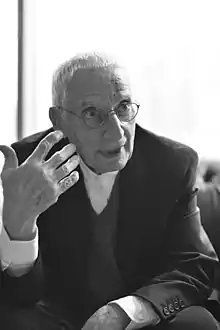Alessandro Mendini
Alessandro Mendini (16 August 1931 – 18 February 2019) was an Italian designer and architect. He played an important part in the development of Italian, Postmodern, and Radical design. He also worked, aside from his artistic career, for Casabella, Modo and Domus magazines.
Alessandro Mendini | |
|---|---|
 | |
| Born | Alessandro Mendini 16 August 1931 |
| Died | 18 February 2019 (aged 87) |
The character of his design is marked by what was his strong interest in mixing different cultures and different forms of expression; he created graphics, furniture, interiors, paintings and architecture and also wrote several articles and books. He was renowned as an enthusiastic member of jury in architectural competitions for young designers. He taught at the University of Milan.
Mendini was born in Milan. He graduated from Politecnico di Milano in 1959 with a degree in architecture and worked as a designer with Marcello Nizzoli.[1] He was the editor-in-chief of Domus magazine from 1979 to 1985 and changed the landscape of modern design through his quintessential works of postmodernism, such as the Proust Armchair and the Groninger Museum. Just as works of the Renaissance period expressed human values and sensibilities, Mendini contributed to bringing into the heart of design those “values” and “sensibilities” that have been eclipsed by commercialism and functionalism. He collaborated with leading international brands including Cartier, Hermes, Swarovski, Venini,[2] and Supreme.
From 1989 up until his death in Milan in 2019 he ran his own practice in Milan, the Atelier Mendini, together with his younger brother Francesco Mendini (b. 1939).
"even if you’ve never heard of Alessandro Mendini, you’re bound to have been affected by his work. That’s because our lives would be different without him." - Alice Rawsthorn- Director, London Design Museum
Career



In the 1970s Mendini was one of the main personalities of the Radical design movement. He became one of the founding members of the "Global Tools" collective, which was set up in 1973.[3] In 1978 he joined the Studio Alchimia as a partner and there he worked with Ettore Sottsass and Michele De Lucchi. Mendini created a Proust chair that combines existing designs and abstract forms with a new concept of Re-Design. This chair proves that his experimental attempts are possible not only by experiment but also by realistic design logic. In 1982 he co-founded Domus Academy, a private postgraduate design school in Milan.
As an architect, he designed several buildings; for example the Alessi residence in Omegna, Italy; the theater complex "Teatrino della Bicchieraia" in the Tuscan city of Arezzo; the Forum Museum of Omegna, a memorial tower in Hiroshima, Japan; the Groninger Museum in The Netherlands and the Arosa Casino in Switzerland. Especially, The Groninger Museum is considered one of the most amazing postmodern buildings of the late 20th century, and was also selected as one of the “1001 Buildings You Must See Before You Die.”
His work in product design was influential in the sense that it pushed the boundaries of what products could be. A notable example is his Lassú chair from 1974, a chair built on top of a pyramid structure, which forgoes conventional notions of function. Mendini was addressing the domestic object as a conduit for spirituality, an idea reinforced by his ritualised burning of the chair, photographed for placement on the cover of Casabella in 1975.[4][5]
As designer, the historical value of the RAMUN amuleto lamp designed in 2010 is the ring shape that accentuates the strengths of LED, which enhances lighting uniformity. The use of a transparent material flaunts the mechanism of the lamp. A mix of various colors in the minimalist structure, consisting of circles and straight lines without any spring or wire, inspires human sensibility. Thanks to its beautiful design and superior performance, the lamp is permanently displayed at the Moderne der Pinakothek in Munich, Germany, The Chicago Athenaeum Museum of Architecture and Design, the Groninger Museum in Netherlands, the Design Museum Denmark, DDP in Korea and the Tsinghua University Art Museum in China.
Awards
Alessandro Mendini was awarded several international prizes, including the Compasso d'Oro in 1979,1981 and in 2014. In 2011, he was awarded with the title Doctor Honoris Causa of the Ecole normale supérieure de Cachan. In 2014, he was awarded with The European Prize for Architecture by The Chicago Athenaeum and The European Centre for Architecture Art Design and Urban Studies. He held an honorary title from the Architectural League of New York as well as the title of Chevalier des Arts et des Lettres from the French Republic.
References
- Hauffe, Thomas (1998). Design: A Concise History. London: Laurence King. pp. 151–152. ISBN 9781856691345.
- http://venini.com/en/authors/alessandro-mendini-eng/
- Lees-Maffei, Grace; Fallan, Kjetil (2013). Made in Italy: Rethinking a Century of Italian Design. London: Bloomsbury Publishing. p. 153. ISBN 978-1-472-55842-8. OCLC 858763457.
- "Archived copy". Archived from the original on 2011-09-25. Retrieved 2011-09-14.CS1 maint: archived copy as title (link)
- http://www.dwell.com/articles/Glenn-Adamson-on-Postmodernism.html
Further reading
- (in Italian) Alessandro Mendini - Museo di Omegna, in "Area" n. 51, July/Aug. 1999, pp. 126–129 Online version
External links
| Wikimedia Commons has media related to Alessandro Mendini. |
- Atelier Mendini website
- (in Italian) Traarchit - architecture - Alessandro Mendini
- Ramun.com - Mendini's amuleto